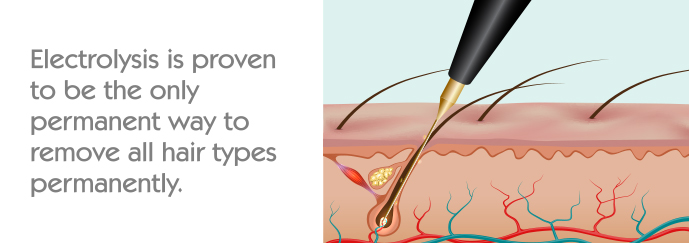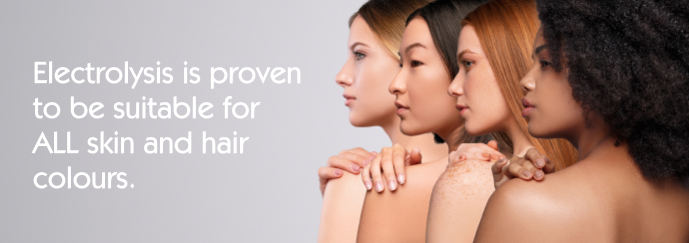Email Enquiries
Electrolysis for Permanent Hair Removal
Electrolysis is still the only technique that is legally acknowledged by the FDA as a permanent hair removal process and is also approved by the ‘British Medical Association’ (BMA). There are several modalities offered including ‘short wave diathermy’ (Radio frequency/Thermolysis) ‘galvanic’ and ‘blend’ currents. A brief overview of this treatment is that a small filament is placed within the hair follicle and a controlled amount of energy released. This facilitates the killing of both hair germ cells and stem cells, removing all potential for further growth of hair within the follicle. However, it is a gradual process, and a course of treatments will be required to achieve success. The reason for this will be described in detail at your consultation, as many factors need to be taken into account such as: hair type, skin type, skin reactivity/sensitivity, growth cycle, previous removal processes, hereditary factors and the effects of medication and abnormal hormone imbalances. The negative emotional effects of unwanted hair should never be underestimated. Seeking professional help and guidance can be life changing and boost self-confidence immeasurably - so don't worry, just call and I will be happy to help!
Your Consultation
Your first visit is an essential time for both you and I to establish what your specific requirements are and whether a suitable and appropriate treatment could be provided. This session is a mandatory requirement prior to treatment and the information gathered is taken in line with GDPR data privacy and protection guidelines.This session will include:
| Personal and contact details | Medical history |
| Skin types, condition/healing reactions | Advanced skin analysis (as appropriate) |
| Contra-Indications | Allergy testing (when required) |
| Contra-actions to treatment | After-care products and protocols |
| Modalities and techniques used | Treatment planning |
Your questions answered
Ample time will be given for a thorough explanation of the treatment and your questions will be addressed. If we both agree that treatment would be both appropriate and beneficial, and that a satisfactory outcome can be expected, then a test area will be provided. Depending on the outcome of this session, an individual treatment plan will be discussed and developed to work towards your expectations and lifestyle. With some individuals, there may be occasions when abnormal endocrinal imbalances are suspected particularly in the case of Poly Cystic Ovary Syndrome (PCOS), and it may be advisable to liaise with your General Practitioner to help support this process! Please be assured that there is never any obligation to continue with any treatment either at the outset or during a course of treatment.How does Electrolysis work
Electrolysis, over many years, has proven time and time again to be a very reliable and only way to remove ALL types of hair permanently! It can be used on fine vellus hair, strong deep rooted, white and red hair colourings and on all skin types. The different modalities available for the Electrolysist to use are Short Wave Diathermy (a.c.), Galvanic (d.c.) and Blend techniques (a.c. & d.c.). They will all be explained during the consultation.Alternating current or “shortwave diathermy” creates vibrations and friction within the follicle which in turn produces heat to cauterise and coagulate the cells of the hair and follicle structures. This modality is quick and effective to use.
Direct Current or 'Galvanic' takes a little longer to activate. It transforms the natural salt and water within the hair follicle into a chemical substance called 'Sodium Hydroxide' (Lye). This ‘chemical’ is most active in the lower part of a hair follicle where there is the highest proportion of moisture. This technique utilises this gentle caustic action to also coagulate the hair germ and stem cells and follicle structures.
‘Blend’ is another popular modality which combines both shortwave and galvanic currents within the follicle, this in turn also cauterises and coagulates the targeted structures. All these modalities and the many treatment techniques will be explained at the time of your consultation. You will be fully informed and educated so you will be left in no doubt as to their uses and benefits and how the different modalities can be used to your benefit.
Although electrolysis has been available for many years, the latest digital technology has secured it as still the only way to safely and permanently remove all types of hairs whether very fine or strong and deep-rooted hairs including red, grey, blonde and white hair colourings and on all skin types! I use the latest up-to-date equipment and pre-sterilised (single use only) attachments to maintain the highest standards of hygiene for your comfort and care.
How many hairs can be treated in a single session
The number of hairs that can be treated at any one time varies considerably. The hair density, techniques and modality chosen directly reflects on speed. A small sparse area on the chin could be cleared within a single visit of 15 minutes. If a larger or more dense area needs to be treated, then a longer treatment time will be needed and only part clearance maybe achieved. However, the most important thing is that accuracy is maintained throughout. Rest assured that the quickest and most effective technique will always be adopted to suit the individual’s requirements and skin tolerances.The Hair growth cycle
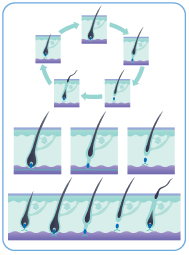 The time it takes for a hair to first start to grow and to die off and be shed varies greatly depending on where it is on the body. E.g. the hair on the head can grow for up to 7 years while eyebrow or eyelash hairs complete the cycle within just a few weeks!
The time it takes for a hair to first start to grow and to die off and be shed varies greatly depending on where it is on the body. E.g. the hair on the head can grow for up to 7 years while eyebrow or eyelash hairs complete the cycle within just a few weeks!When the hair is in its 'Growing Stage' (anagen) it is attached to the base of the hair follicle, which has an area fed by its blood supply (dermal papilla) at which, treatment can be very effective. A fine filament is inserted down into each hair follicle and a small discharge of energy is released at the ‘base’ and ‘bulge’ of the follicle to coagulate or cauterise the structures within. The released energy targets the blood supply, germ cells and stem cells, which are all needed for hair growth. After sufficient treatment the follicle loses its ability to produce a hair and dies – permanently!
However, not all hairs are in the 'Growing’ stage at the time of treatment and some hairs are likely to be in their 'Changing' (catagen) or 'Dormant’ Stage (telogen). The 'Changing’ hair detaches from the blood supply and migrates to the upper part of the hair follicle, leaving the lower part behind to shrink back until another hair is activated again. It now becomes a detached 'Dormant’ hair where it dries out. This dormant hair may stay in situ for some time until it either falls out of its own accord or is pushed out by the reactivation of a new growing hair (early anagen) from underneath! The most appropriate choice of modality and electrolysis technique will be aligned to the growing cycle of the hair by your electrologist.
'It is important to note that no matter what growth stage the hair is in (Anagen, Catagen or Telogen), electrolysis will still target stem cells and be very effective in destroying the growth potential of the hair follicle!
Causes of hair growth
The amount of treatment required varies greatly between the individual, as the cause of the hair growth problem is a key factor. Causes such as; Hereditary Factors, Topical Irritation, Transgender Change, Certain Medications, Normal and Abnormal Systemic and Endocrinal Imbalances are all reasons why unwanted hair can be stimulated. Even with normal hormonal changes such as Puberty, Pregnancy and Menopause individuals can have a predisposition to increased and unwanted hair growth and want to search for a permanent solution. The progression of the treatment is guided by you, your hair growth, skin type and tolerances and your practitioner will take into account the amount of sensation control needed to keep the treatment within your comfort zone!Electrolysis - Prices
|
Full Consultation
(See above)
|
£45
|
|
Full Consultation with ‘test patch’
(See above)
|
£55
|
|
Prices are dependent on session time.
A deposit will be required to secure your booking!
Minimum session up to 10 minutes… Thereafter, with increments of 5 minutes
up to 60 minutes…
Longer sessions are available on request.
NB: Depending on growth cycles your session times may vary. The duration of your session will include skin preparation, modality adjustments and aftercare product application.
|
From £22
Up to £70
|

Transgender Electrolysis Treatments
Welcome to this section if you are considering full or part Gender Re-assignment (Male to Female/Female to Male). The re-assignment process is not an easy decision to take and there are a lot of physical and emotional obstacles to be encountered, one of which is dealing with a strong hair growth. In my experience the transgender client has actively researched this subject and is well versed with their treatment options for permanent hair removal, they may now be at the point at which an experienced practitioner is being sought to consult with. Permanent hair removal by electrolysis is an important part of both pre- and post-re-assignment and having over 37 years of experience in electrolysis I have worked successfully with many transgender clients in that time. I would like to reassure you that I can make a positive contribution to this process for both beard hair and pre-surgery sites and all enquiries are confidential. If treatment is not available on the NHS then it falls to private clinics such as The Diathermy Skin Clinic, to provide this service. The advantage being that the amount, or length of treatment sessions you require are rarely restricted and progression can be as swift as you wish it to be.
How many treatments will I need?
The strong terminal growth, particularly on the beard area, requires a certain commitment by the client/patient – a timeline for completion is difficult to determine for many reasons. For example; hair growth can be sparse on one person and dense on another which would require much more treatment. An individual will have different attendance requirements and may chose just a short session each week, while others may decide to have longer sessions or more frequent. Hence the area covered, and quantity of hair removed will vary tremendously. The number of sessions and time allowed reflects on treatment planning and the strategy for completion. It is best to measure your progress more as a ‘clearing’ rather than how many sessions – a ‘clearing’ indicates that all unwanted hair in the chosen area has been successfully treated once and you generally need a minimum of 3 ‘clearings’, working at the optimum rate, to achieve your results. However, medically guided hormone treatment will support this process achieving a quicker completion time. During this process, hair growth gradually disappears and the necessity for lengthy appointments becomes much less and session times reduce considerably. However, if you chose not to take the hormonal support option you will still achieve your goal, albeit it may take a little longer. The day to day management and preparation of an area needed for treatment will be discussed at the consultation and your treatment plan programmed to lessen any unnecessary disruption to your lifestyle requirements.N.B. - Please note that I have a limited amount of space for NHS patients and there may be a waiting list running if all places are full. So, please call and I will be glad to advise you.
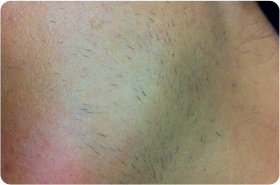

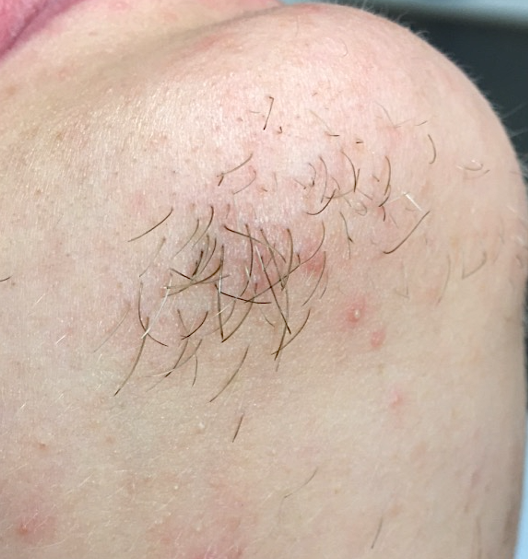
(Wendy)
(K.T. Dewsbury)
(P – Leeds)
(Anon – W. Yorks)

Telephone: 01924 635006
Site designed and built by PAB Studios Ltd

